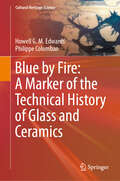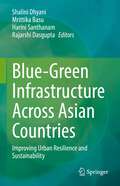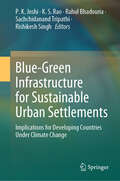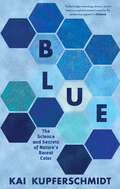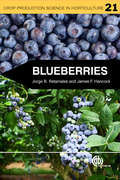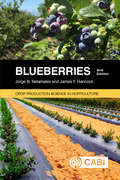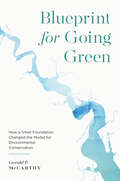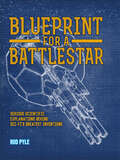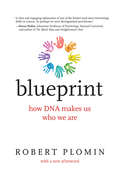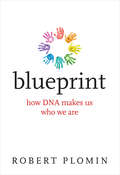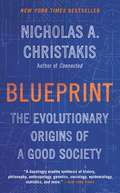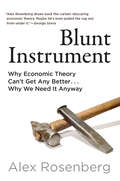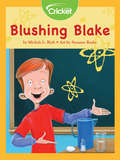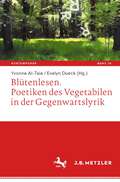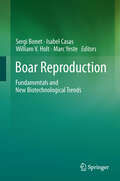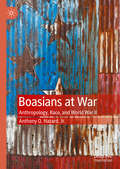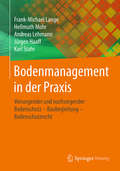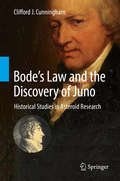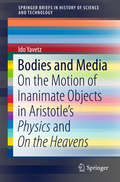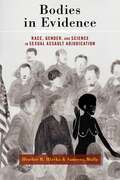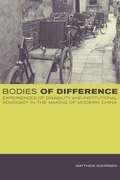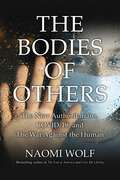- Table View
- List View
Blue and Green: The Drive for Justice at America's Port (Urban and Industrial Environments)
by Scott L. CummingsHow an alliance of the labor and environmental movements used law as a tool to clean up the trucking industry at the nation's largest port. In Blue and Green, Scott Cummings examines a campaign by the labor and environmental movements to transform trucking at America's largest port in Los Angeles. Tracing the history of struggle in an industry at the epicenter of the global supply chain, Cummings shows how an unprecedented “blue-green” alliance mobilized to improve working conditions for low-income drivers and air quality in nearby communities. The campaign for “clean trucks,” Cummings argues, teaches much about how social movements can use law to challenge inequality in a global era.Cummings shows how federal deregulation created interrelated economic and environmental problems at the port and how the campaign fought back by mobilizing law at the local level. He documents three critical stages: initial success in passing landmark legislation requiring port trucking companies to convert trucks from dirty to clean and drivers from contractors to employees with full labor rights; campaign decline after industry litigation blocked employee conversion; and campaign resurgence through an innovative legal approach to driver misclassification that realized a central labor movement goal—unionizing port truckers.Appraising the campaign, Cummings analyzes the tradeoffs of using alternative legal frameworks to promote labor organizing, and explores lessons for building movements to regulate low-wage work in the “gig” economy. He shows how law can bind coalitions together and split them apart, and concludes that the fight for legal reform never ends, but rather takes different turns on the long road to justice.
Blue by Fire: A Marker of the Technical History of Glass and Ceramics (Cultural Heritage Science)
by Howell G. Edwards Philippe ColombanThe use of natural mineral and synthetic blue pigments in antiquity for wall paintings and illuminated manuscript historiation evolved into the most suitable blue pigments for the decoration of glazed and enamelled wares (ceramics, glass and metal) which required a stability at the high temperatures of the kilns used for glazing and firing. Historic literature is often vague regarding the blue pigments used for this purpose. The generic term “cobalt blue” covers a wide range of pigments that were actually used for the decoration of faience, majolica, stonewares, earthenwares and porcelains. This book addresses the application of elemental and molecular spectroscopic analytical techniques to a range of diverse problems which arise for decorated ceramics, glass and enamels and related artefacts: a history of techniques, provenance and authentication. The text contains an introduction to the important analytical techniques that are used in destructive and nondestructive analytical measurements and highlights potential future applications based upon novel miniaturised instrumentation for in-situ studies. The book is co-authored by two international experts with many years’ experience in the application of analysis to artworks and archaeological artefacts and in the investigation of materials and sites for cultural heritage preservation. Among 19 chapters one is devoted to an evaluation of the analytical techniques that are used and the pitfalls which can arise in the interpretation of the data. The approach conveys the detailed information which has become available from the adoption of analytical techniques to diverse problems through the scientific interrogation of ceramic and related artefacts. Examples are given of how the pigment analysis and sourcing can provide unique information about ancient trade routes and pigment sourcing historically. A classic instance is provided by the transfer of European enamelling technologies carried out at the beginning of the 17th century in Japan (Arita) and at the turn of the 17th-18th centuries in China by the Jesuits established at the Court of, respectively, the Kyushu island of Daymios and the Chinese Qing Empero Kangxi. It has hence been demonstrated that some of the most beautiful porcelains emanating from Japan and China in this period incorporate blue decoration with pigments supplied from Europe. The interpretation of the analytical data can assist museum curators, archaeologists, art dealers/experts and cultural heritage historians in the preservation and conservation of ancient materials which have applied blue pigment decoration.
Blue-Green Infrastructure Across Asian Countries: Improving Urban Resilience and Sustainability
by Rajarshi Dasgupta Shalini Dhyani Mrittika Basu Harini SanthanamThis edited book discusses Blue-Green Infrastructure (BGI) from conception to implementation in building resilience and urban sustainability. The book emphasizes on infrastructures, institutions, and perceptions as three main pillars of implementing and managing successful BGI, with a special focus on Asia. The book highlights concepts as well as field-based experiences from different parts of Asia by experts, with a special focus on advances and opportunities in advancing BGI, challenges and constraints, followed by case studies on BGI mainstreaming. It addresses sustainable water management, multiscale environmental design, environmental risk assessment, and finally understanding policy implications and concerns for BGI mainstreaming in growing urban sprawls of the region. There has been growing global momentum and recognition of Blue-Green Infrastructure (BGI) as a multifunctional Nature-based Solution (NbS) with multiple co-benefits. There is strong evidence from many urban centres of Europe, USA, China, and South Africa demonstrating that mainstreaming BGI can help in addressing growing vulnerability of urban areas by ensuring safety, resilience, and sustainability for urban residents in the warming world. This book is a timely contribution for researchers, students, scholars, urban planners, consultants, and policy makers in the fields of environment, resilience, urban planning, climate adaptation, and sustainability science.
Blue-Green Infrastructure for Sustainable Urban Settlements: Implications for Developing Countries Under Climate Change
by P. K. Joshi K. S. Rao Rishikesh Singh Rahul Bhadouria Sachchidanand TripathiBlue-Green Infrastructure (BGI) is now recognized as beneficial in terms of maintaining water flows and thermal comfort in urban areas. A framework of ecosystem services for urban settlements may be instrumental in bio-physical benefits as well as social and psychological benefits that will be assisting in adaptation and mitigating adverse effects of changing climate. Cities in developing countries, where the land cover is undergoing rapid transition, are characterized primarily by urban characteristics at the expense of natural ecosystems. The book aims to provide a state of the art of Urban Resilience and Sustainability linked to blue-green components of the urban environment. The challenges and opportunities in adopting the blue-greens as next generation infrastructure, particularly in the context of rampant urbanization and changing climate are also one of the focal areas of the book. The book also deals with multilevel community and stakeholders’ participation in developing and managing Blue-Green Infrastructure in urban centres of developing countries. Currently, the focus of researches in urban ecosystem is moving towards exploring the role of blue-green components in ameliorating the negative consequences of urbanization and changing climate. This book bridges the knowledge gap between the existing understating of the role of blue and green infrastructure separately and in integration in city planning, particularly in mitigating and adapting to changing climate and environmental pollution.
Blue: The Science And Secrets Of Nature's Rarest Color
by Kai KupferschmidtWhat is it about the color blue? Blue is our favorite color globally—the darling of artists since the time of the pharaohs. So it’s startling to turn to the realms of nature and discover that “true” blue is truly rare. The sea and sky are blue, but we can’t bottle this trick of physics. And the few creatures, plants, and minerals that appear blue are almost all deceiving us. There’s no blue pigment in a blue jay—it would be brown but for how its feathers distort light. Kai Kupferschmidt has been enraptured by blue since childhood. In Blue, he invites readers on his globe-trotting quest to understand his favorite color— from Kyoto, where scientists are trying to engineer a blue rose, to Brandenburg, where conservationists hope to save the “little blue macaw.” Deep underground where blue crystals grow and miles overhead where astronauts gaze at our “blue marble” planet-wherever he finds this alluring color, it has a story to tell.
Blueberries
by Professor James F Hancock Jorge B RetamalesBlueberry cultivation has increased dramatically as production has shifted into new regions. Blueberries are now widely available as food and also processed to be used in medicine and pharmaceuticals for their antioxidant properties. This new and practical book covers the major topics of interest to blueberry breeders and researchers including botany, physiology, nutrition, growth regulation, photosynthesis, environment, weeds, pests, diseases and postharvest management. The main focus is on the most important cultivated species, the highbush blueberry, although information on other blueberries and related species is also provided. It is an essential resource for soft fruit researchers, extension workers, academics, breeders, growers, and students.
Blueberries (Crop Production Science in Horticulture)
by James Hancock Jorge RetamalesBlueberry cultivation has increased dramatically as production has shifted into new regions. Blueberries are now widely available as food and also processed to be used in medicine and pharmaceuticals for their antioxidant properties. This new and updated edition covers the major topics of interest to blueberry breeders and researchers including botany, physiology, nutrition, growth regulation, photosynthesis, environment, weeds, pests, diseases and postharvest management. The main focus is on the most important cultivated species, the highbush blueberry, although information on other blueberries and related species is also provided. It is an essential resource for soft fruit researchers, extension workers, academics, breeders, growers, and students.
Blueberries: A Century of Research
by Ronald KorcakBlueberries: A Century of Research presents the results of basic and applied research into blueberry science and culture around the world. It contains technical reports on genetics, nutrition, physiology, culture, and harvesting of several blueberry species. Readers will find much current, helpful, and interesting information for their work with blueberries.General areas covered in the book are the blueberry culture and its future, blueberry genetics and diseases, blueberry nutrition, and blueberry fruit quality. Specific chapters address a variety of topics including: utilization of wild blueberry germplasm use of sparkleberry in breeding highbush cultivars identification of markers linked to genes controlling chilling requirement and cold hardiness detection of blueberry scorch virus and red ringspot virus methods of controlling blueberry gall midge damage control of bunchberry in wild blueberry fields blueberry nitrate reductase activity use of gibberellic acid as a management tool for increasing yield of rabbiteye blueberry blueberry culture and research in JapanIn Blueberries: A Century of Research, small fruit researchers, extension workers, and blueberry specialists will find important new information for continued improvement of blueberry culture and specialization. The book is a vital resource that appeals to a professional audience worldwide.
Blueprint for Going Green: How a Small Foundation Changed the Model for Environmental Conservation
by Gerald P. McCarthyHow one organization took on industrial pollution—and the lessons for our new century In 1977, one forward-thinking judge took an ecological disaster—the poisoning of the James River by Allied Chemical—and turned it into a great environmental-protection legacy. The $8 million payment made by Allied would go on to fund the game-changing Virginia Environmental Endowment.Blueprint for Going Green provides an insider&’s account of the remarkable results of this landmark ruling and the foundation it spawned. Over the following decades, the VEE helped to grow the fledgling environmental movement in Virginia into a powerful force for protecting the state&’s water quality and conserving its landscape. This inspiring story reveals how a small group can make a profound difference by engaging in public policy work, funding science to advance public policy, and helping to build a lasting and effective citizen-led environmental movement. Finalist for the Southern Environmental Law Center's Phillip D. Reed Environmental Writing Award
Blueprint for a Battlestar: Serious Scientific Explanations Behind Sci-Fi's Greatest Inventions
by Rod Pyle“An enjoyable source of information on a wide variety of real or imagined technological marvels of the space age.” —National Space SocietyThis beautifully illustrated pop science book answers the enduring questions raised by science fiction, such as: Do hoverboards really exist, how can you bring a dinosaur back to life and can we really travel in time and space.Packed with stunning images, including seventy-five illustrations created exclusively for this book, Blueprint for a Battlestar takes twenty-five remarkable and memorable technologies from the world of sci-fi, from Star Wars and The Matrix to Ironman and The Terminator. Each concept will be explained and dissected to reveal the real science behind it. Some are boldly obvious—such as the Death Star and exoskeletons—and some less so (think bio-ports or cloaking devices). All are fascinating and will make wonderful explorations into the science of the future as we understand it today.“This is dream fuel for aspiring STEM students of all sorts. Blueprint for a Battlestar is a gateway drug for brainstorming that could change the world.” —Seattle Book Review“Will take readers on a fact-finding mission where the science is explained and the fiction just may become reality. Can it really work? For the sake of all those young engineers out there dreaming of a future filled with massive battlestars stretching far across the galaxy, we can only hope.” —Amazing Stories Magazine“A fun book that offers serious exploration of some of the technology that could be common place in the not too distant future.” —The Review Graveyard
Blueprint: How DNA Makes Us Who We Are
by Robert PlominA top behavioral geneticist makes the case that DNA inherited from our parents at the moment of conception can predict our psychological strengths and weaknesses. In Blueprint, behavioral geneticist Robert Plomin describes how the DNA revolution has made DNA personal by giving us the power to predict our psychological strengths and weaknesses from birth. A century of genetic research shows that DNA differences inherited from our parents are the consistent lifelong sources of our psychological individuality—the blueprint that makes us who we are. Plomin reports that genetics explains more about the psychological differences among people than all other factors combined. Nature, not nurture, is what makes us who we are. Plomin explores the implications of these findings, drawing some provocative conclusions—among them that parenting styles don't really affect children's outcomes once genetics is taken into effect. This book offers readers a unique insider's view of the exciting synergies that came from combining genetics and psychology. The paperback edition has a new afterword by the author.
Blueprint: How DNA Makes Us Who We Are (The\mit Press Ser.)
by Robert PlominA top behavioral geneticist makes the case that DNA inherited from our parents at the moment of conception can predict our psychological strengths and weaknesses.In Blueprint, behavioral geneticist Robert Plomin describes how the DNA revolution has made DNA personal by giving us the power to predict our psychological strengths and weaknesses from birth. A century of genetic research shows that DNA differences inherited from our parents are the consistent life-long sources of our psychological individuality—the blueprint that makes us who we are. This, says Plomin, is a game changer. Plomin has been working on these issues for almost fifty years, conducting longitudinal studies of twins and adoptees. He reports that genetics explains more of the psychological differences among people than all other factors combined. Genetics accounts for fifty percent of psychological differences—not just mental health and school achievement but all psychological traits, from personality to intellectual abilities. Nature, not nurture is what makes us who we are.Plomin explores the implications of this, drawing some provocative conclusions—among them that parenting styles don't really affect children's outcomes once genetics is taken into effect. Neither tiger mothers nor attachment parenting affects children's ability to get into Harvard. After describing why DNA matters, Plomin explains what DNA does, offering readers a unique insider's view of the exciting synergies that came from combining genetics and psychology.
Blueprint: The Evolutionary Origins of a Good Society
by Nicholas A. ChristakisDrawing on advances in social science, evolutionary biology, genetics, neuroscience, and network science, Blueprint shows how and why evolution has placed us on a humane path -- and how we are united by our common humanity. For too long, scientists have focused on the dark side of our biological heritage: our capacity for aggression, cruelty, prejudice, and self-interest. <P><P>But natural selection has given us a suite of beneficial social features, including our capacity for love, friendship, cooperation, and learning. Beneath all our inventions -- our tools, farms, machines, cities, nations -- we carry with us innate proclivities to make a good society. <P><P> In Blueprint, Nicholas A. Christakis introduces the compelling idea that our genes affect not only our bodies and behaviors, but also the ways in which we make societies, ones that are surprisingly similar worldwide. <P><P>With many vivid examples -- including diverse historical and contemporary cultures, communities formed in the wake of shipwrecks, commune dwellers seeking utopia, online groups thrown together by design or involving artificially intelligent bots, and even the tender and complex social arrangements of elephants and dolphins that so resemble our own -- Christakis shows that, despite a human history replete with violence, we cannot escape our social blueprint for goodness. <P><P>In a world of increasing political and economic polarization, it's tempting to ignore the positive role of our evolutionary past. But by exploring the ancient roots of goodness in civilization, Blueprint shows that our genes have shaped societies for our welfare and that, in a feedback loop stretching back many thousands of years, societies have shaped, and are still shaping, our genes today. <P><b>A New York Times Bestseller</b>
Blunt Instrument: Why Economic Theory Can't Get Any Better...Why We Need It Anyway
by Alex RosenbergWhy economic theory—with no track-record of predictive success—is still an indispensable tool for protecting civilized life.Economic theory has never gotten any better at prediction. Its explanations are always after the fact. The mathematical models economists have devoted themselves to for more than a century can&’t be improved to enhance their empirical relevance. But from this research program that never paid off, a very useful tool has emerged—game theory. It&’s just what civilized society needs to protect itself from the rapaciousness that condemns all markets to fail. In Blunt Instrument, Alex Rosenberg helps explain to outsiders exactly what they need to make sense of economic theory, and why despite its failures, it&’s still indispensable.Economic theory is something we all should understand because the economy affects us all, and it is economic theorists who shape that economy for good or ill. No less an economist than John Maynard Keynes expressed the point in a memorable quotation: &“Practical men, who believe themselves to be quite exempt from any intellectual influence, are usually the slaves of some defunct economist.&” This book draws back the curtain from the math and the graphs that deliver microeconomic and macroeconomic models. It demystifies the formidable-looking equations, explaining the reasoning behind the math so that outsiders can decide on the theory&’s importance to their own thinking about the economy. Finally, it shows how game theory—the study of strategic choice—emerged from the outlandish idealizations of economic theory. Most importantly, it illuminates how game theory both mitigates the failures of real-world economies and improves the design of important human institutions.
Blushing Blake
by Michele L. RichBlake has an embarrassing experience presenting during a science presentation to his class. He cleverly uses that situation as the starting point for a new experiment.
Blütenlesen. Poetiken des Vegetabilen in der Gegenwartslyrik (Kontemporär. Schriften zur deutschsprachigen Gegenwartsliteratur #16)
by Yvonne Al-Taie Evelyn DueckLieß Brechts zum Diktum gewordenes Versfragment «Gespräch über Bäume» die Naturlyrik zum fragwürdigen Genre werden, so rief es gleichwohl bald Widerspruch hervor, nicht nur in Paul Celans lyrischer Replik «Ein Blatt, baumlos» und den ebenfalls auf Brecht antwortenden Gedichten Erich Frieds und Günter Eichs, sondern auch in der engagierten ökokritischen Dichtung seit den 1970er Jahren. Während das «Gespräch über Bäume» vor allem auf Natur und Landschaft als Gegenstand und Thema von Dichtung bezogen ist, fragt dieser Sammelband, wie das gegenwärtige Interesse an der Natur mit Formfragen und deren poetologischen Reflexionen in der deutschsprachigen Lyrik seit den 1990er Jahren einhergeht. Wie verbinden sich diese Formfragen und ihre poetologischen Reflexionen in der Gegenwart mit einem diachron weitgefassten Blick auf Ornamente und Schreibweisen wie Arabesken und Grotesken, Gattungsbezeichnungen wie Silven oder Florilegien, arboreale und mykologische Strukturmodelle wie Baumdiagramme, Rhizome oder Myzele, die auf vegetabile Formvorbilder zurückgreifen? Wie lassen sich diese Darstellungen des Vegetabilen in der Dichtung auf naturwissenschaftliche Verfahren der Sichtbarmachung oder das morphologische und botanische Wissen über Bau- und Formprinzipien der Pflanzen beziehen? Von diesen Beobachtungen ausgehend fragen die Beiträge dieses Bandes, welche Poetologien des Vegetabilen die deutschsprachige Gegenwartslyrik ausgebildet hat und wie sich darin botanisches Wissen, medienkritisches Bewusstsein und ästhetisches Naturerleben zu neuen dichterischen Formen verschränken.
Boar Reproduction: Fundamentals and New Biotechnological Trends
by Isabel Casas Marc Yeste Sergi Bonet William V HoltLatent knowledge in the field of pig reproduction is vast but scattered, making it difficult to take in all information at a glance. Moreover, nascent branches in biotechnology cannot grow if deprived of roots. The book Boar Reproduction: Fundamentals and New Biotechnological Trends links the past, the present and the emerging scientific research fields on reproductive biotechnology, offering a rigorous but easy to follow compilation of topics, from "old favorites" to the latest advances. The book is organized in three parts. The chapters of the first and second part cover various biological aspects of boar spermatozoa within the male, and within the female environments, respectively. The most common laboratory and artificial insemination techniques are discussed in the third part. As an additional feature, some chapters focus on the basis of a technology transfer to bring research expertise from basic science to the market, making the information provided in this book suitable for academic, research and other professional applications.
Boasians at War: Anthropology, Race, and World War II
by Anthony Q. Hazard, Jr.This volume seeks to recover a specific historical moment within the tradition of anthropologists trained in the United States under Franz Boas, arguably the father of modern American anthropology. Focusing on Boasians Ashley Montagu, Margaret Mead, Melville Herskovits, and Ruth Benedict, Anthony Hazard highlights the extent to which the Boasians offer historicized explanations of racism that move beyond a quest to reshape only the discipline: Boasian war work pointed to the histories of chattel slavery and colonialism to theorize not just race, but the emergence of racism as both systemic and interpersonal. The realities of race that continue to plague the United States have direct ties to the anthropological work of the figures examined here, particularly within the context of the 20th-century black freedom struggle. Ultimately, Boasians at War offers a detailed glimpse of the long troubled history of the concept of race, along with the real-life realities of racism, that have carried on despite the harnessing of scientific knowledge to combat both.
Bodenmanagement in der Praxis: Vorsorgender und nachsorgender Bodenschutz – Baubegleitung – Bodenschutzrecht
by Karl Stahr Frank-Michael Lange Hellmuth Mohr Andreas Lehmann Jürgen HaaffDie wichtigsten Gesetze und Verordnungen werden vorgestellt und die Rechtslage an Hand aktueller Rechtssprechung dargelegt. Erkundungs- und Bewertungstechniken werden beschrieben und kommentiert und die relevanten Normen und technischen Regelwerke sind aufgef#65533;hrt. Das Buch gliedert sich in die drei Bereiche Altlasten, Abfalltechnik - soweit Bodenkundlich relevant - und Oberbodenmanagement. Letzteres wird im Zuge von Ausgleichsma#65533;nahmen zu Bauvorhaben vermehrt von zust#65533;ndigen Beh#65533;rden eingefordert.
Bode’s Law and the Discovery of Juno: Historical Studies in Asteroid Research
by Clifford J. CunninghamBased on extensive primary sources, including many documents from Olbers, Gauss, Zach, and Regner never previously translated into English, this is the definitive account of the origins of Juno and Vesta by Hershel. Primary sources about the discovery are included in new translations, including personal correspondence and scientific papers. Cunningham, a dedicated scholar of asteroids, opens to scrutiny this critical moment of astronomical discovery, continuing the story begun in Volumes I, II and III of this series. The discovery of this new class of celestial bodies, as well as the revelation of the existence of the Asteroid Belt, set off an entirely new understanding of the Solar System, the implications of which are thoroughly discussed. How the discovery of Juno influenced Bode in his thinking about "Bode's Law" is studied, and the volume concludes with a look at the instruments and observatories that analyzed the asteroids in these early years of the nineteenth century.
Bodies and Media: On the Motion of Inanimate Objects in Aristotle’s Physics and On the Heavens (SpringerBriefs in History of Science and Technology)
by Ido YavetzThis book presents a recasting of Aristotle's theory of spatial displacement of inanimate objects. Aristotle's claim that projectiles are actively carried by the media through which they move (such as air or water) is well known and has drawn the attention of commentators from ancient to modern times. What is lacking, however, is a systematic investigation of the consequences of his suggestion that the medium always acts as the direct instrument of locomotion, be it natural or forced, while original movers (e. g. stone throwers, catapults, bowstrings) act indirectly by impressing moving force into the medium. Filling this gap and guided by discussions in Aristotle's Physics and On the Heavens, the present volume shows that Aristotle's active medium enables his theory - in which force is proportional to speed - to account for a large class of phenomena that Newtonian dynamics - in which force is proportional to acceleration - accounts for through the concept of inertia. By applying Aristotle's medium dynamics to projectile flight and to collisions that involve reversal of motion, the book provides detailed examples of the efficacy and coherence that the active medium gives to Aristotle's discussions. The book is directed primarily to historians of ancient, medieval, and early modern science, to philosophers of science and to students of Aristotle's natural philosophy.
Bodies in Evidence: Race, Gender, and Science in Sexual Assault Adjudication
by Heather R. Hlavka Sameena MullaWinner, 2021-2022 AES Senior Book Prize, awarded by the American Ethnological SocietyHonorable Mention, Senior Book Prize of the Association for Feminist AnthropologyUncovers how the process of sexual assault adjudication reinforces inequality and becomes a public spectacle of violenceFor victims in sexual assault cases, trials rarely result in justice. Instead, the courts drag defendants, victims, and their friends and family through a confusing and protracted public spectacle. Along the way, forensic scientists, sexual assault nurse examiners, and police officers provide their insight and expertise, shaping the story that emerges for the judge and jury. These expert narratives intersect with the stories of victims, witnesses, and their communities to reproduce our cultural understandings of sexual violence, but too often this process results in reinscribing racial, gendered, and class inequalities. Bodies in Evidence draws on observations of over 680 court appearances in Milwaukee County’s felony sexual assault courts, as well as interviews with judges, attorneys, forensic scientists, jurors, sexual assault nurse examiners, and victim advocates. It shows how forensic science helps to propagate public misunderstandings of sexual violence by bestowing an aura of authority to race and gender stereotypes and inequalities. Expert testimony reinforces the idea that sexual assault is physically and emotionally recognizable and always leaves material evidence. The court’s reliance on the presence of forensic evidence infuses these very familiar stereotypes and myths about sexual assault with new scientific authority. Powerful, unflinching, and at times heartbreaking, Bodies in Evidence reveals the human cost of sexual assault adjudication, and the social cost we all bear when investing in forms of justice that reproduce inequality and racial injustice.
Bodies in Space (Fountas & Pinnell Classroom, Guided Reading Grade 5)
by Sunita ApteMISSION TO MARS? Are humans ready to go to Mars? Our minds might say yes, but our bodies would disagree. Weird things happen to the human body in space. Find out why space scientists have some big concerns about people voyaging to the Red Planet. NIMAC-sourced textbook
Bodies of Difference: Experiences of Disability and Institutional Advocacy in the Making of Modern China
by Matthew KohrmanBodies of Difference chronicles the compelling story of disability's emergence as an area of significant sociopolitical activity in contemporary China. Keenly attentive to how bodies are embedded in discourse, history, and personal exigency, Matthew Kohrman details ways that disability became a fount for the production of institutions and identities across the Chinese landscape during the final decades of the twentieth century. He looks closely at the creation of the China Disabled Persons' Federation and the lives of numerous individuals, among them Deng Pufang, son of China's Communist leader Deng Xiaoping.
Bodies of Others: The New Authoritarians, COVID-19 and the War Against the Human
by Naomi WolfThe Bodies of Others is about how we came to the harrowing civilizational crossroads at which we find ourselves - engaged in a war against vast impersonal forces with limitless power over our lives and which threaten the freedoms we have always taken for granted. In her most provocative book yet, Dr. Naomi Wolf shows how these forces—from Big Tech and Big Pharma to the CCP and our oligarchical elites—seized upon two years of COVID-19 panic in sinister new ways, to not only undermine our Republic but to fundamentally reorient human relations. Their target is humanity itself. Their end goal is to ensure that our pre-March 2020 world is gone forever. Irretrievable. To be replaced with a world in which all human endeavor—all human joy, all human fellowship, all human advancement, all human culture, all human song, all human drama, all worship, all surprise, all flirtation, all celebration—is behind a digital paywall. A world in which we will all have to ask technology's permission to be human. But we, the people of the world, did not vote to abandon our old systems and destroy our old ways so absolutely they could never be recovered. And Wolf shows how, against overwhelming odds, we still might win.

